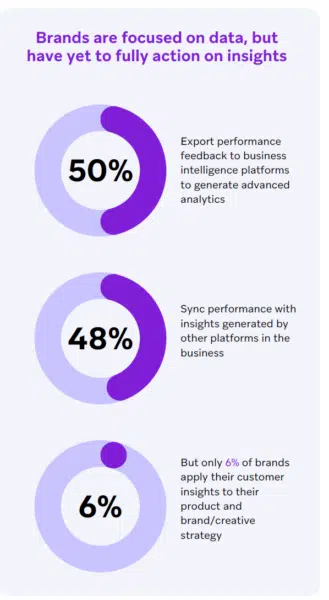MARKETING
Only 6% of global marketers apply customer insights to product and brand

While many brands talk about focusing on the customer, few do it. Less than a quarter (24%) of global brands are mapping customer behavior and sentiment, according to Braze’s 2024 Customer Engagement Review. What’s worse, only 6% apply customer insights to their product and brand approach.
“At the end of the day, a lot of companies operate based on their structure and not how the consumer interacts with them,” Mariam Asmar, VP of strategic consulting, told MarTech. “And while some companies have done a great job of reorienting that, with roles like the chief customer officer, there are many more that still don’t. Cross-channel doesn’t exist because there are still all these silos. But the customer doesn’t care about your silos. The customer doesn’t see silos. They see a brand.”
Half of all marketers report either depending on multiple, siloed point solutions to cobble together a multi-channel experience manually (33%); or primarily relying on single-channel solutions (17%). Only 30% have access to a single customer engagement platform capable of creating personalized, seamless experiences across channels. This is a huge problem when it comes to cross-channel, personalization.
The persistence of silos
The persistence of data silos despite decades of explanation about the problems they cause, surprised Asmar the most.

“Why are we still talking about this?” she said to MarTech. “One of the themes I see in the report is we’re still getting caught up on some of the same stumbling blocks as before.”
She said silos are indicative of teams working on different goals and “the only way that gets unsolved is if a leader comes in and aligns people towards some of those goals.”
These silos also hinder the use of AI, something 99% of respondents said they were already doing. The top uses of AI by marketers are:
- Generating creative ideas (48%).
- Automating repetitive tasks (47%).
- Optimizing strategies in real-time (47%).
- Enhancing data analysis (47%).
- Powering predictive analytics (45%).
- Personalizing campaigns (44%).
Despite the high usage numbers, less than half of marketers have any interest in exploring AI’s potential to enhance customer engagement. Asmar believes there are two main reasons for this. First is that many people like the systems they know and understand. The other reason is a lack of training on the part of companies.
Dig deeper: 5 ways CRMs are leveraging AI to automate marketing today
“I think about when I was in advertising and everybody switched to social media,” she told MarTech. “Companies acted like ‘Well, all the marketers will just figure out social media.’ You can’t do that because whenever you’re teaching somebody how to do something new there’s always a level of training them up, even though they’re apps that we use every day, as people using them as a business and how they apply, how we get impact from them.”
The good news is that brands are setting the stage for the data agility they need.
- 50% export performance feedback to business intelligence platforms to generate advanced analytics.
- 48% sync performance with insights generated by other platforms in the business.
Also worth noting: Marketers say these are the four main obstacles to creativity and strategy:
- Emphasis on KPIs inherently inhibits a focus on creativity (42%).
- Too much time spent on business-as-usual execution and tasks (42%).
- Lack of technology to execute creative ideas, (41%).
- Hard to demonstrate ROI impact of creativity (40%).


Methodology
The 2024 Global Customer Engagement Review (registration required) is based on insights from 1,900 VP+ marketing decision-makers across 14 countries in three global regions: The Americas (Brazil, Mexico, and the US), APAC (Australia, Indonesia, Japan, New Zealand, Singapore, and South Korea), and EMEA (France, Germany, Spain, the UAE, and the UK).
Get MarTech! Daily. Free. In your inbox.


















